
Sales Meeting: A Complete Guide to Seal the Deal
Sales meetings can go two ways: they’re either the moment you crush it and move closer to the goal, or they leave everyone wondering, “Why did we even meet?”
Did you know a poorly planned sales meeting wastes an average of 31 hours per employee every month? On the other hand, a single well-run meeting can increase your chances of achieving the sales goal by over 50%.
The good news? Running a great sales meeting isn’t rocket science—it just takes a little planning, the right mindset, and a few smart moves.
But, after doing all these things still, you can miss the meeting. The reason is the lake of perfect scheduling of your sales meeting. So, what’s the solution?
In this guide, we’ll discuss everything you need to know, from setting clear goals to keeping the meeting focused. And, by the end, you’ll know how to turn every sales meeting into a productive and impactful meeting and schedule your meeting with the right tool.
Let’s get started.
What is a Sales Meeting?
A sales meeting is a gathering organized by a company’s sales department to discuss goals, share updates, set appointments, and improve performance. It often focuses on sales strategies, policies, procedures, and specific products or services.
These meetings are very important for your company. It not only helps your sales teams to build better relationships but also find areas where things can improve, and make sure your company’s products meet your customer needs. And, it gives your team a chance to come up with new ideas for products or services that can help the business grow.
The primary purpose of a these meeting is to generate new ideas and drive better results. Here are some major purposes of a sales meeting to achieve great results:
- Share Updates
- Provide the latest information on your company’s products, services, pricing, and value proposition.
- Keep your team informed about changes that could impact their sales efforts.
- Get Feedback
- Hear directly from your sales reps about their experiences with potential customers.
- Identify common challenges or roadblocks they face in closing deals.
- Evaluate and Improve
- Analyze your overall team performance to pinpoint areas for improvement.
- Collaborate on actionable strategies to move forward together with clear goals and a unified approach.
Types of Sales Meetings
There are no specific types of sales meetings. It depends on the company and its activities. But in general sales meetings can be of several types:
- Weekly Sales Meetings: These keep the team on track, discussing progress and challenges to maintain momentum.
- Sales Pitch Meetings: These are focused on winning clients, requiring preparation and a tailored approach to close deals.
- Pipeline Review Meetings: These help identify opportunities, track stages of deals, and avoid missing potential sales.
- Team Meetings: Regular team check-ins help boost communication, share updates, and align everyone toward shared goals.
- One-on-One Meetings: The sales manager and the sales reps discuss individual sales performances, set goals, and solve problems in one-on-one meetings.
- Brainstorming Meetings: These develop new ideas for sales, marketing, or strategy in the brainstorming sessions.
- Forecasting Meetings: These foresee sales in the future and align goals, resources, and plans by studying data trends.
- Training Meetings: Training sessions can keep the team aware of the right sales skills, knowledge, and preparation to handle the sales job at hand effectively.
- Annual Sales Conference: A huge event to team bond, set goals, and celebrate achievements.
- Strategic Planning Meetings: These lay down the long-term sales strategies in order to fall in line with market trends and business goals.
- Feedback Sessions: Open discussions are very helpful to the team for its improvement and building strong communication between the sales leaders and salespeople.
- Product Launch Meetings: These get the team prepared for confidently and knowingly promoting new products.
Sales Meeting Agendas and Ideas to Boost Productivity
A sales meeting agenda is essential for keeping you and your team focused and making the best use of your time. Without it, you risk losing direction or wasting time on unimportant topics. Also, a clear agenda helps you stay on track and get things done efficiently.
Here are some key points and sales meeting topics to make your meetings more productive, engaging, and maybe even a little fun:
- Review Performance: You can discuss last week’s sales achievements, challenges faced, and key customer feedback with your sales team.
- Set Goals: You can set clear vision and team objectives to focus on efforts for the upcoming week.
- Sales Training: You can conduct role-playing exercises and share best practices for improving sales techniques with your sales teams.
- Lead & Pipeline Updates: Review the current status of leads, and upcoming follow-ups, and prioritize key accounts with all.
- Market Research: Share any recent competitor activities and industry trends that could impact your company’s sales strategies. Use a proxy scraper to track competitor activity and industry trends.
- Product Updates: Provide updates on new product features and inform any product-related challenges in the sales process and try to make a solution with the team.
- Recognition: You can give rewards to your top performers and share their successful sales stories to motivate the other team members.
- Q&A Session: You can open the floor to address team concerns, ask for feedback, and discuss any sales topic in the question and answer session.
- Action Items: Assign specific tasks to each team member with clear deadlines for follow-up.
How to Run an Effective Sales Meeting [10 Easy Steps]
As we said earlier, sales meetings are very important for a productive sales team. But not every meeting is productive without perfect structure and purpose, it can quickly become a waste of time. So, running a successful sales meeting with proper strategies is very important.
Here are some steps you can follow to run your sales meetings perfectly and ensure your meetings are engaging and impactful:
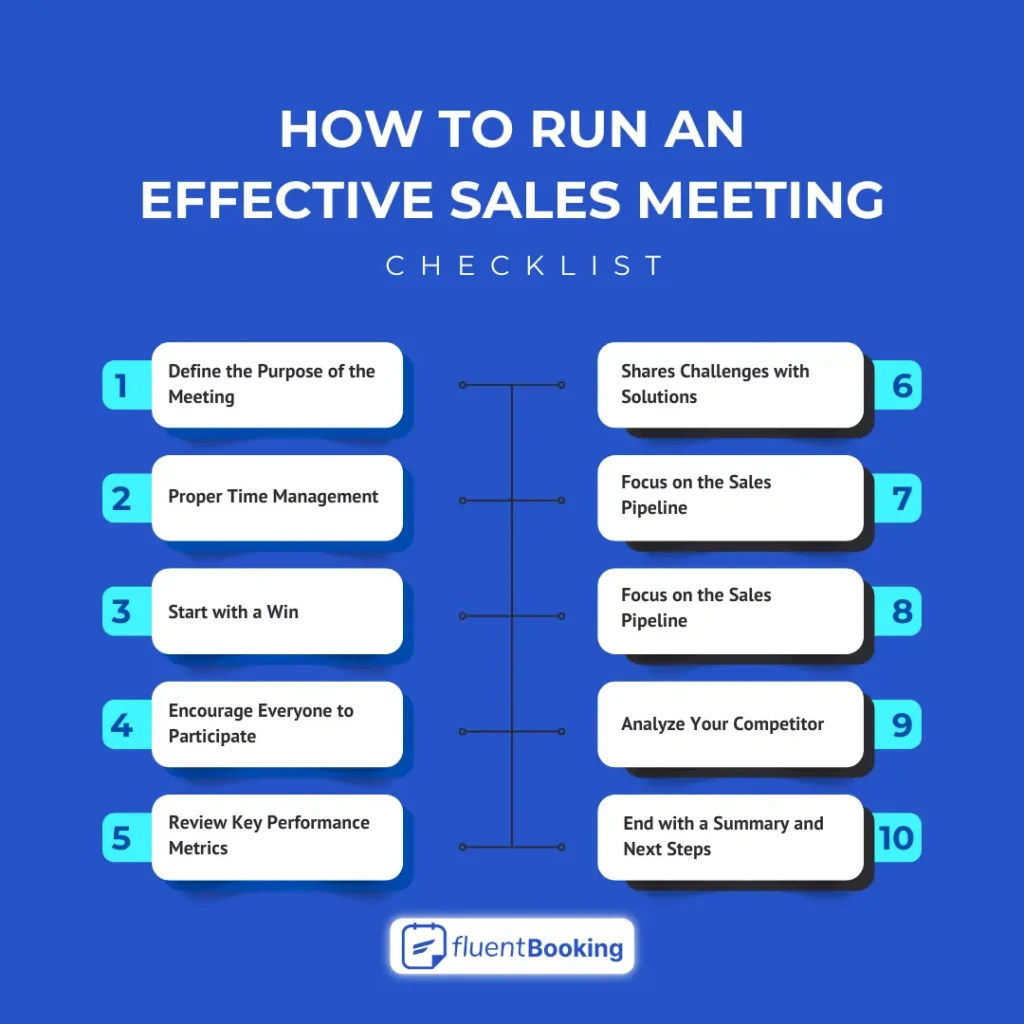
Define the Purpose of the Meeting
Every sales meeting starts with a clear purpose. So, firstly decide your sales targets, it can be analyzing sales performance, resolving challenges, or brainstorming new strategies.
Then, you have to create a concise agenda that outlines the discussion points and expected outcomes and share it with your team. Which will ensure your team is prepared, aligned, and ready to contribute.
Proper Time Management
In sales, time is money. So make every minute of your meeting count. You have to stick to the scheduled start and end times and show respect for everyone’s busy day. Also, avoid off-topic and keep your discussions focused on the agenda.
A well-timed meeting not only respects your team’s time but also keeps the energy high and enhances engagement.
Start with a Win
Start your sales meeting by celebrating your team’s recent successes. It can be a big sale, a good negotiation, or even a positive customer review. By recognizing these wins you can create a positive atmosphere and motivate everyone for better sales.
Encourage Everyone to Participate
Your sales meetings will be much more effective when everyone gets involved. Ask your team to share their stories, try role-playing pitches, or throw out ideas. Also, you can encourage friendly competition and reward the top performers.
When you create a space where everyone feels included and heard, you’ll unlock fresh ideas and better solutions. Plus, it shows your team that their input matters, which keeps them motivated and engaged.
Review Key Performance Metrics
Reviewing performance metrics is very important for every sales meeting, like sales figures, conversion rates, and other key performance indicators (KPIs). In every meeting, you can talk about how close your team is to meeting the goals set in the previous meeting. It can be weekly, or monthly.
Also, after discussing these metrics you can identify what’s going well and what could be improved in the future and you can improve your sales strategies.
Shares Challenges with Solutions
You have to encourage your team member to have an open conversation where everyone can share their obstacles, whether it’s difficulties with a particular lead, issues in the sales process, or roadblocks with tools and resources.
Once challenges are identified, collaborate with the full team to brainstorm and come up with a solution. This approach not only helps resolve issues quickly but also promotes a sense of unity and teamwork. In this way, these open discussions can boost team collaboration and innovative thinking.
Focus on the Sales Pipeline
Take time to review the current state of the sales pipeline. Identify prospects which stuck in certain stages, discuss strategies to move them forward, and ensure no opportunities are overlooked.
Review Customer Feedback
Customer reviews are a valuable source of information that sales teams often overlook. By reviewing feedback, teams can identify patterns, product issues, and areas where service or sales might need improvement.
For example, product reviews can reveal what customers like or dislike, while service feedback can point out areas for improvement. Analyzing this feedback helps the team adjust their approach and better meet customer needs.
Analyze Your Competitor
Competitor analysis is very important for any sales meeting. You have to research what works for your competitors. Sometimes, they solve the challenges completely differently, and this can give you fresh ideas for boosting your sales. First, you have to note their sales strategies, how they handle sales conversations, and the materials they use in their presentations or brochures.
A side-by-side comparison is good to understand how well they hold up against each other. You might find they are good at qualifying leads or adding value. Knowing the competition helps frame your sales pitch so that you remain competitive.
End with a Summary and Next Steps
Wrap up the meeting by highlighting the key points discussed and assigning action items to every team member with clear deadlines. Also, make sure everyone understands their tasks and responsibilities to keep things moving forward.
5 Tools to Run Effective Sales Meetings
So, to run a meeting smoothly, just a pen and paper is not enough. There are many advanced tools available, you can use for a perfect and impactful sales meeting. Here are five simple but very useful tools you can use to run your sales meeting for free.
Easy Scheduling Tool
Many of us forget about our meeting time and date. It’s very common but dangerous also, right? And you have to schedule different types of sales meetings which is very tough to organize and maintain the time schedule. That’s why scheduling sales meetings can be a hassle without the right system in place.
For this problem, FluentBooking can be your best choice. It is the best scheduling WordPress plugin for scheduling your important sales meetings. By using it you can –
- Schedule one-on-one, group, round-robin, or collective meetings effortlessly
- Sync with your favorite calendars to avoid double bookings
- Send automatic email/SMS reminders to make sure no one forgets
- Make scheduling effortless for both you and your clients
- Integrate easily with popular video conferencing tools like Google Meet, MS Teams, or Zoom
- Automate communication with FluentCRM and improve conversion
- Manage appointments as projects in FluentBoards and minimize scope creep
- Integrate and share your Google Calendar with FluentBooking
- Import ICS file and share your booking information
Seal the Deal with FluentBooking!
Schedule flexible sales meetings in FluentBooking, meet with your prospects or team, and close more deals. Choose your best meeting format and start scheduling.
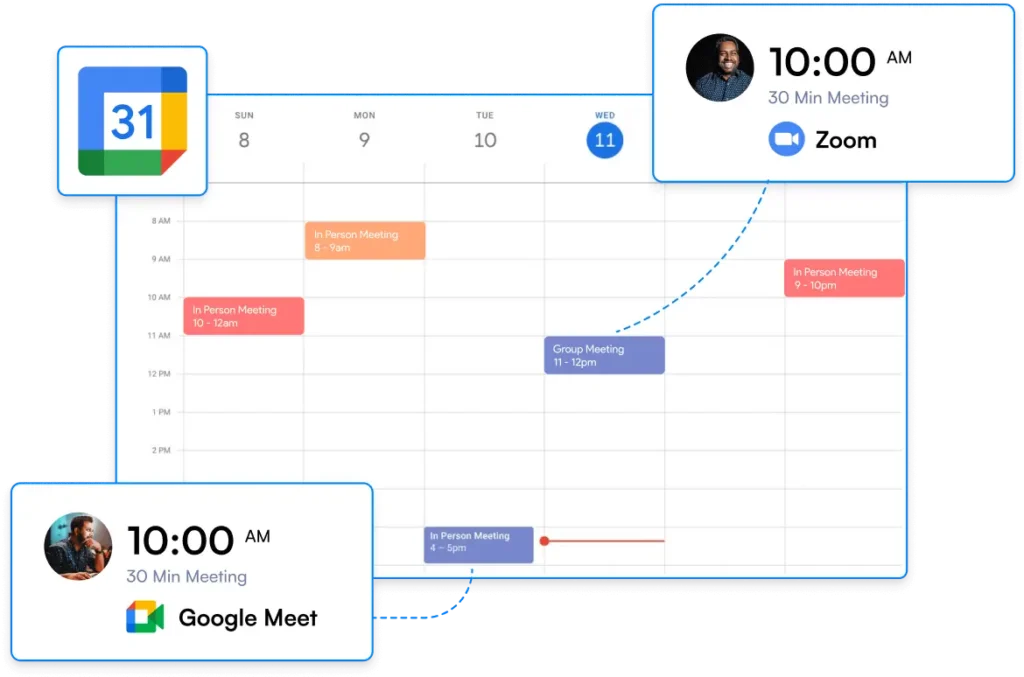
Customer Relation Management Tool
A CRM system is a customer relations management tool. You can use it to organize member information, track interactions, and manage your sales pipeline. Keeping track of your prospects and follow-ups is easier with a tool like FluentCRM.
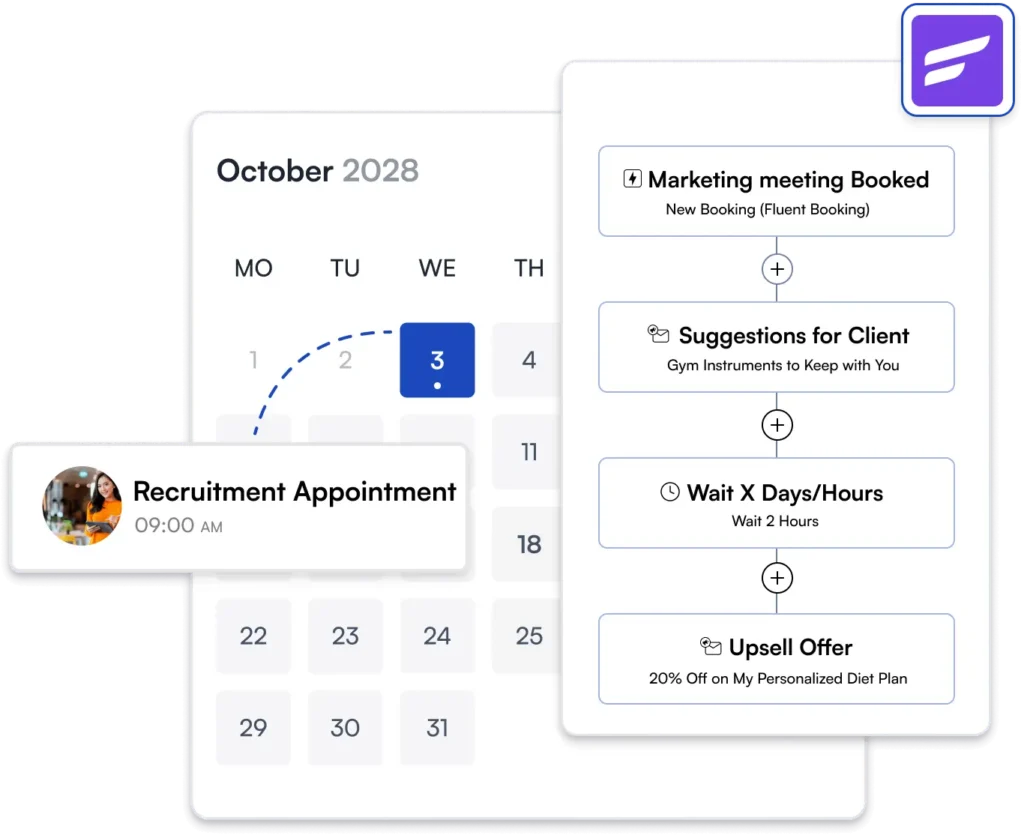
It helps you to:
- Know your client’s needs and past interactions before the meeting
- Sending personalized follow-up emails promptly before or after the meeting
- Creating automated sequences to nurture leads who need more time to decide
- Monitoring open rates and engagement to refine your follow-up strategy
Video Conferencing Platforms – Meet Anywhere
For any emergency or reasons like COVID-19, if you can’t arrange a meeting physically, you can arrange a virtual meeting by using some simple and useful software. Your team members or prospects can attend virtually. And for this, tools like Zoom or Google Meet make it easy to connect.
This platform is very useful because you can;
- Talk face-to-face even if you’re miles apart
- Share your screen for demos or slides
- Record meetings to review or share later
Presentation Tools – Keep it Engaging
In a sales meeting, you have to present too many things to your team, and the presentation should be attractive because good visuals can make your pitch memorable. You can use tools like PowerPoint or Canva to:
- Create slides that explain your ideas clearly.
- Use visuals to make your message stand out.
Using an AI avatar generation tool can help you create personalized, human-like avatars for video presentations—making your sales content more engaging and professional without the need for on-camera presence. This is especially useful when creating pre-recorded sales pitches or training materials.
Project Management Tool
After the sales meeting, your next steps should be to manage specific tasks and deadlines for every member which is the key to keeping the deal moving forward. You can use FluentBoards, a project management plugin for WordPress.
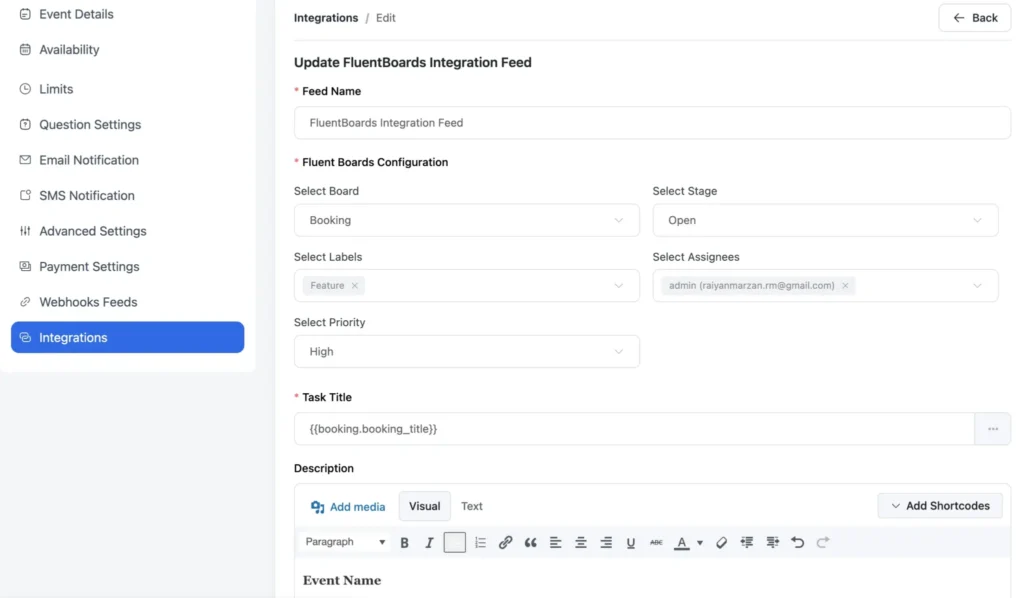
It can make your project management easier by:
- Assigning tasks to your team with clear deadlines
- Tracking progress to ensure nothing slips through the cracks
- Keep everything organized in one place, so you stay on track
Call Center Software
In any sales meeting, discussing customer interactions and improving communication strategies is key. This is where call center software like AirCall can be a game-changer. It allows sales teams to:
- Analyze call data and performance metrics to identify areas for improvement
- Record and review sales calls to enhance training and strategy discussions
- Integrate seamlessly with CRMs to ensure all customer interactions are logged
- Improve customer engagement by providing real-time insights and call routing for better service
Using call center software ensures that sales teams have all the data they need to make informed decisions and optimize their sales strategies effectively.
Sales Meeting Best Practices for Better Productivity
An effective sales meeting is crucial for aligning your team, setting clear goals, and driving results. Here are some best practices for sales meetings to ensure your meetings are effective and productive:
Before the Meeting
Before starting the meeting, it’s very important for you to be prepared and plan all the things you want to do in your sales meeting. Here’s how:
- Set a Clear Objective: Firstly, you have to define the purpose of the meeting. It can be reviewing the sales pipeline, planning strategies, or addressing challenges, it helps to clear your goal and ensures everyone stays focused.
- Share a Focused Agenda: You can provide a detailed agenda earlier, outlining topics and time limits. This helps participants prepare and keeps discussions focused.
- Invite Only Essential Participants: Limit attendees to those directly involved or impacted by the meeting’s agenda. A smaller, relevant group ensures efficiency and meaningful contributions.
During the Meeting
Once you’re in the meeting room, it’s all about keeping things on track and making sure everyone feels heard in the meeting:
- Start and End on Time: Everyone’s time is valuable. So the starting and finishing should be planned which shows respect for everyone’s time and level up their energy.
- Make It a Conversation: Encourage your team member to share their thoughts and ideas. Also, you can use simple tools like polls or quick check-ins to keep everyone engaged.
- Stick to the Agenda: You have to stick only to your meeting agenda. Because staying focused helps you get the most out of your time together.
- Wrap Up with a Plan: Before ending, note everything and plan for the next week or month, who’s doing what, and when it needs to be done. Ultimately, clear action steps are the key to making progress.
After the Meeting
The meeting doesn’t end when everyone logs off. You have some responsibility after the meeting also :
- Send Follow-ups: Share a summary of what was discussed, the decisions made, and the tasks assigned by follow-up emails. This keeps everyone on the same page and avoids confusion later.
So, by following these best practices of your sales meeting, you can transform your boring meeting into a productive sales meeting. It can be brainstorming strategies or closing deals, the key is to stay focused, organized, and action-oriented.
Final Thought: Turn Sales Meetings into Wins
So, from now on we can say you don’t have to feel that a sales meeting is time-wasters. With a structured agenda, the right preparation, and effective tools, they can be a big change in your overall sales team’s performance.
Start by planning, keeping discussions focused, and wrapping up with clear next steps for everyone. A little preparation goes a long way in turning your meetings into moments that drive results and help your business grow.
Now it’s your turn—get started with smarter scheduling, better organization, and stronger teamwork. Let your sales meetings set you up for success!
Frequently Asked Questions
Ratul Ripon
I enjoy making complex ideas simple and engaging through my writing and designs. With a strong knowledge on content writing and SEO, I create technical content that’s both easy to understand and interesting.
Table of Content
Subscribe To Get
WordPress Guides, Tips, and Tutorials








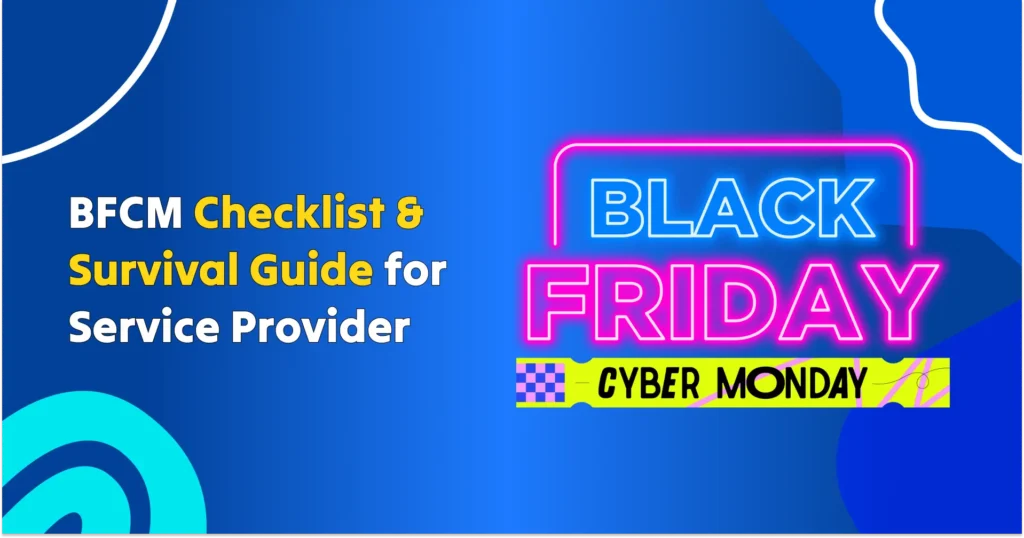
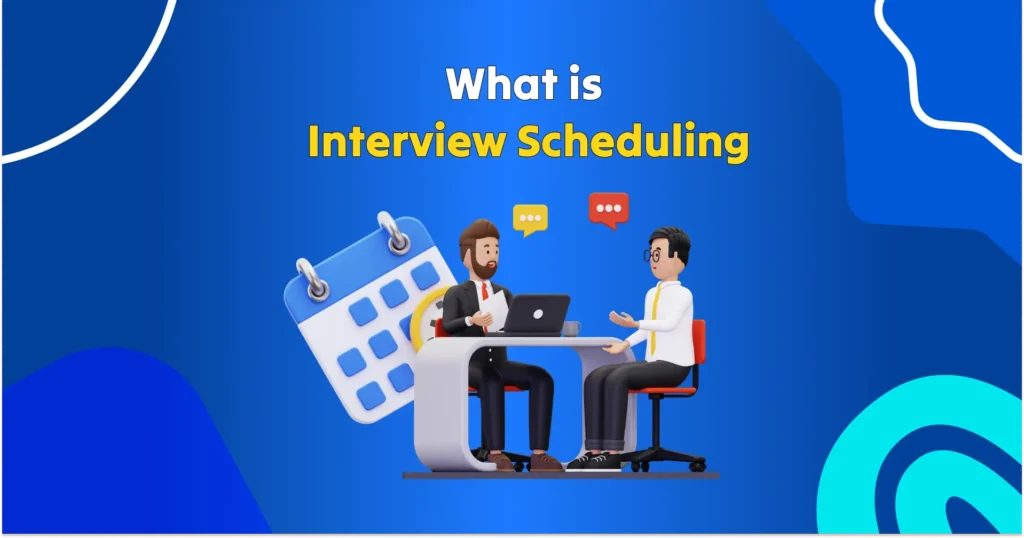

Leave a Reply